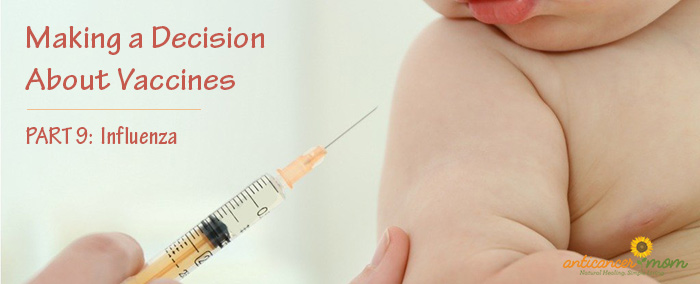
If you find yourself weighing the pros and cons of the flu vaccine vs. actually getting the flu, then this post is for you. Chances are you have already done a bit of research, but what is true versus sensationalized or fear-based information?
For all of you who followed me last year on Facebook, you may know that my ENTIRE family got the flu last Christmas. It was a good TWO weeks before we all were “flu-free.” But we still will not get the flu shot this year. Think we’re crazy?
Read on to see why we are perfectly sane. 😉
This is Part 9 in my vaccine series discussing which vaccines we decided to give to our children and why. You may also want to check out the other posts in this series:
Part 1: Our Vaccine Choice: Risks, Benefits, Responsibility
Part 2: Hepatitis B and Hib Vaccines
Part 3: Diphtheria, Tetanus and Pertussis Vaccine
The Pros and Cons of the Flu Vaccine vs. the Flu
Vaccine Effectiveness
The first thing we need to look at when weighing the pros and cons of the flu vaccine is exactly HOW effective the flu vaccine really is.
When I wrote my posts about, for example the measles, I wrote how difficult our decision was because of the rapid effectiveness of that vaccine after initial uptake.
With flu vaccine, the effectiveness after vaccination is not impressive and actually wanes considerably after initial injection.
A Canadian study looking at this past flu season’s vaccine suggested 10-17% protection to the most severe form of flu, H3N2 in the individuals studied. For all flu strains total (in most flu vaccines there are three to four strains total,) protection was believed to be 40-55%.
In the U.S, similar numbers have been reported by the CDC (where the same flu vaccine technology has been used) with anywhere from 40-60% total effectiveness and 33% effectiveness against the more severe H3N2 flu.
Flu vaccine effectiveness is defined as “protects against the risks of the flu.” This means that participants in studies may have been infected by the flu virus, but they did not need medical intervention or die from the flu, (meaning they could still spread flu and be sick enough to stay home from work- or not.)
You can find additional studies on U.S. populations and Spanish populations from 2017-2018, here. The results were all similar, from 25-45% efficacy.
In this 2013 study of ~1,441 people including 839 children, there was no difference in flu occurrence between individuals vaccinated and those who chose not to receive the vaccine.
This right here is why I find it appalling that so many in the medical profession are required to get flu shots or they’ll be fired from their job. The science is just not backing this up and perhaps even adding a dangerous false sense of security amongst those vaccinated.
Vaccine-induced flu immunity wanes quickly.
A study of 45,000 flu-vaccinated people published last month in Clinical Infectious Diseases found that vaccine-induced flu immunity wanes up to 16% every 28 days after vaccination. This means someone vaccinated early on in the flu season, may be practically non-immune at the peak of flu season, especially since vaccine effectiveness maxes out at ~50% with currently offered vaccines.
A look at flu mortality statistics since 1900:
This look at data above from 1900-2004 shows that the flu vaccine had very little to do with the reduction of mortality from flu and pneumonia combined since 1900. (Source)
Flu vaccination was not widely used until the late 1980’s. The vaccine was first recommended in 1960 and earlier versions were available in the 1940’s.
Even in 2018, we are seeing influenza vaccination rates of around 50% of adults and 60% of children according to the CDC. (Source)
I know that I personally had never even heard of a flu vaccine until the early 2000’s and my family had never received one. It just wasn’t marketed like it is today.
The influenza statistics below (b.) begin in 1930 and are monthly calculations from July-June of each flu “season”, NOT annual numbers but show similar reductions and pattern. (Source)
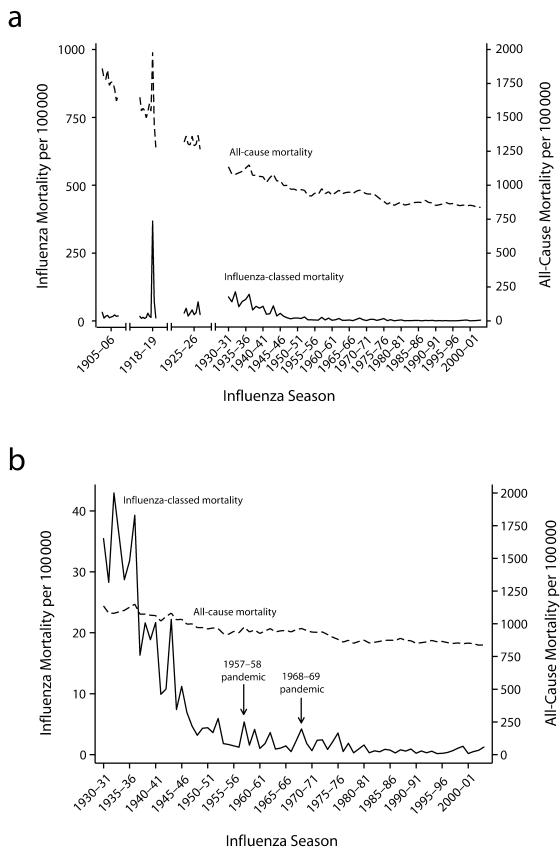
You can see on these graphs that flu mortality has been stable since the late 1970’s.
From the study…
“For the years 1900 through 1904 and 1910 through 1936, monthly death figures were obtained through the annual Mortality Statistics reports published by the Bureau of the Census. I obtained additional figures for the years 1937 through 1993 and 1999 through 2004 from Vital Statistics of the United States or other mortality reports maintained or produced by the CDC’s National Center for Health Statistics.”
The overall decline in influenza-attributed mortality over the 20th century cannot be the result of influenza vaccination, because (influenza) vaccination did not become available until the 1940s and was not widely used until the late 1980s.”
Another study from 2005 of over 30 influenza seasons “could not correlate increasing vaccination coverage after 1980 with declining mortality rates in any age group” (…including those over 65 and infants under 6 months old.)
Since the above graph’s data trail stopped in the early 2000’s, here is the annual flu data from 1999-2015 for those of you curious about that. (Which decreased from 22.8 deaths per 100,000 to 17.8 per 100,000- the vast majority which are in the elderly.)
Combined Influenza and Pneumonia Fatalities
Another point to remember is that influenza data is actually COMBINED influenza and pneumonia data. It is difficult to compare influenza data alone since so many cases go unreported and are not laboratory confirmed, so the CDC uses an estimate system, that is new as of 2017 and combines pneumonia as well.
During October 1, 2017–May 19, 2018, the same flu season that the CDC has estimated there were 80,000 deaths from flu (or more accurately flu + pneumonia combined), clinical laboratories tested 1,210,053 specimens for influenza virus; where 224,113 (18.5%) tested positive. (Source)
This means that 71.5% of cases were non-influenza disease (commonly referred to as “influenza like illness” or ILI) and would not have been affected by the flu vaccine.
Flu Statistics are Skewed and the Media is NOT Trustworthy
This article is the best one I have found looking at the evidence behind last month’s CDC report stating that there were 80,000 deaths from the flu in the 2017-2018 flu season.
What the media does not tell you is that the NFID news conference that reported the 80,000 flu death numbers from last year’s flu season was supported, in part, by the Centers for Disease Control and Prevention, MedStar Visiting Nurse Association, and through unrestricted educational grants from Genentech, GSK, Merck & Co., Inc., Pfizer Inc. and Seqirus, all pharmaceutical companies that market and sell their flu vaccines. NFID also received funding and other support from Sanofi Pasteur. (Source)
This is NOT unbiased information that the media is reporting. These are SPONSORED recommendations.
Basically, the CDC took an estimate based on reported flu deaths (which they assume is vastly underreported), and then they use their own statistical system to give us the 80,000 number.
The problem is, these numbers have absolutely no published evidence to back them up and are based on estimates. As of this writing, we don’t know the exact number of death certificates filed in the 2017-2018 flu season with “influenza” as the cause, but we do know that there have been an average of ~1,000 reported adult flu deaths in previous years.
Childhood deaths from flu last flu season, which are mandatorily reported were 180. (Source)

The only place I could find that actually gave the independent flu numbers by week was here and you can see the significant difference in flu death numbers compared to pneumonia above for previous years. For example, in week 37, the last week of the 2017-2018 flu season, 7 flu deaths were reported compared to 2,329 pneumonia deaths! (See below- Source– via Fluview dashboard.
We are being marketed to…
I think this data is so incredibly important to remember because we are on the constant receiving end of fear-based news and inflated and misleading statistics from the TRILLION dollar vaccine industry.
The CDC even has a marketing plan for how to get more people to get vaccines. You can see the entire presentation here, but this has to be my favorite excerpt (from page 8):
Fostering demand, particularly among people who don’t routinely receive an annual influenza vaccination, requires creating concern, anxiety, and worry. For example:
- A perception or sense that many people are falling ill.
- A perception or sense that many people are experiencing bad illness.
- A perception or sense of vulnerability to contracting and experiencing bad illness.”
-Glen Nowak, Ph.D, CDC Director of Media Relations
The revenue earned by vaccine manufacturers for sales of influenza vaccine is AT LEAST $5 billion each year. You can see the market report HERE that projects that to double in the next few years.
This all on top of the fact that no vaccine manufacturer has been liable for a vaccine injury since the 1986 National Childhood Vaccine Injury Act. In fact, the majority of injury claims paid out by the court (which is funded by taxes placed on the vaccines themselves and paid by the recipient) is from the adult influenza vaccine.
You can see in the official report from the National Vaccination Compensation Program that influenza vaccine-injury cases were four to five times MORE likely to be confirmed and paid out for than other vaccines.
*** Translation: Vaccine injury from the influenza vaccine is 4 to 5 times more common than vaccine injury from any other vaccine! ***
Types of Flu Vaccines
Even with all of the information above, I know there are still some of you that will still want to get your flu vaccine or are advising other family members on what to do. Here’s a bit more about the actual vaccine and how to make an educated choice on which one to receive based on yours or your family’s situation.
In 2018 there are now many brands of flu vaccine available based on age, allergies, and how you prefer to receive it, but there are pros and cons to all.
All flu vaccines are Category B and C drugs, meaning they have not been proven to be safe in pregnant women.
The CDC does provide several studies stating 50-60% less flu severity and death in those vaccinated with the flu vaccine. Many of those studies are listed on this page.
Types of Flu Vaccines and their ingredients:
- Standard trivalent (three virus, approved for 6 months +) – Afluria
- High dose trivalent (for those 65 and older) – Fluzone high dose
- Adjuvant-added flu vaccine (for 65 and older) – Fluad
- Standard quadrivalent (four virus strains- two influenza A and two influenza B) – several brands – Afluria Quadrivalent, Fluarix Quadrivalent, FluLaval Quadrivalent, and Fluzone Quadrivalent. See vaccine inserts for age approval.
- Quadrivalent egg-free flu vaccine- Flucelvax Quadrivalent (for 4 years and older) and Flublok Quadrivalent (for adults 18+)
- Nasal spray quadrivalent flu vaccine – FluMist – (for non-pregnant individuals ages 2-49)
Common ingredients Found in the Injectable Vaccines:
- Various forms of flu virus- both dead and weakened
- Formaldehyde
- Aluminum salts (aluminum toxicity is a real problem- especially when injecting it annually. Read more here.)
- Thimerosal (50% ethylmercury in composition) – mercury-based preservative (this ingredient is a no-go for me. At 25 mcg per flu shot EACH YEAR, this is troubling. Read much more about this here.)
- Chicken egg proteins
- Gelatin
- Antibiotics
- Variety of animal cells and other viral components (see full CDC list here and scroll down to page 2- influenza vaccines.)
Flumist Nasal Vaccine and Ingredients:
The nasal vaccine has been off the market for several years after finding that it was ineffective and sheds substantial amounts of flu virus from the nasal cavity after vaccination, but today it has been approved again for use. Ingredients:
- Four weakened live influenza viruses
- Monosodium glutamate
- Gelatin
- Arginine
- Sucrose
- Dibasic potassium phosphate, monobasic potassium phosphate
- Gentamicin (antibiotic.)
The CDC on the “improvement” of the FluMist vaccine:
“For the 2018-2019 season, the manufacturer of LAIV4 has included a new H1N1 vaccine component. Some data suggest this will result in improved effectiveness of LAIV4 against H1N1. However, no published effectiveness estimates for this vaccine component against H1N1 viruses are yet available. ACIP and CDC voted to resume the recommendation for the use of LAIV4 based on evidence suggesting that the new H1N1 component will result in improved effectiveness of LAIV against these viruses. ” (Source)
So basically, we will see how the nasal vaccine does, but no studies have been done to figure out how effective it really is compared to the 5% effectiveness in children when they decided to pull it off the shelf in 2016.
And then there’s this study (from the Flumist vaccine insert) on how it sheds flu virus in vaccinated individuals. Here’s the data table from the vaccine insert:
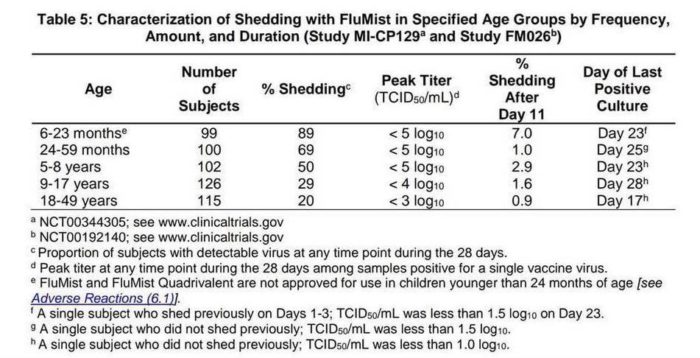
The FluMist website does state:
Vaccine recipients or their parents/guardians should be informed by the healthcare provider that FluMist Quadrivalent is an attenuated live virus vaccine and has the potential for transmission to immunocompromised household contacts.”
They do, however go on to say that this likelihood is low (1-2%,) but then again they profit billions each year from the sale of their vaccine and have very little accountability. You make the call. 🙂
Flu shots have never been studied for safety in pregnant women
Influenza vaccines are all Category B or C drugs which means they have not been adequately studied on pregnant women to confirm fetal safety.
Terminology from several vaccine inserts:
“There are, however, no adequate and well-controlled studies in pregnant women. Because animal reproduction studies are not always predictive of human response, this vaccine should be used during pregnancy only if clearly needed.” (exact wording from several flu vaccine inserts including Fluzone.)
Even with that lack of information, the CDC still recommends flu vaccination for women more than 14 weeks pregnant:
“Animal reproduction studies have not been conducted with influenza virus vaccine. It is also not known whether influenza virus vaccine can cause fetal harm when administered to a pregnant woman. Although animal reproductive studies have not been conducted, the prescribing health care provider should be aware of the recommendations of the Advisory Committee on Immunization Practices. The ACIP states that if used during pregnancy, administration of influenza virus vaccine after 14 weeks of gestation may be preferable to avoid coincidental association of the vaccine with early pregnancy loss.”
If you are pregnant and debating on getting the flu vaccine, these are excellent points to bring up with your OBGYN who may be pressuring you about the vaccine. Also, according to the CDC, only 36% of pregnant women receive the flu vaccine which is a good indicator, that despite all of the pressure from the medical community, women are still not comfortable receiving this vaccine while pregnant.
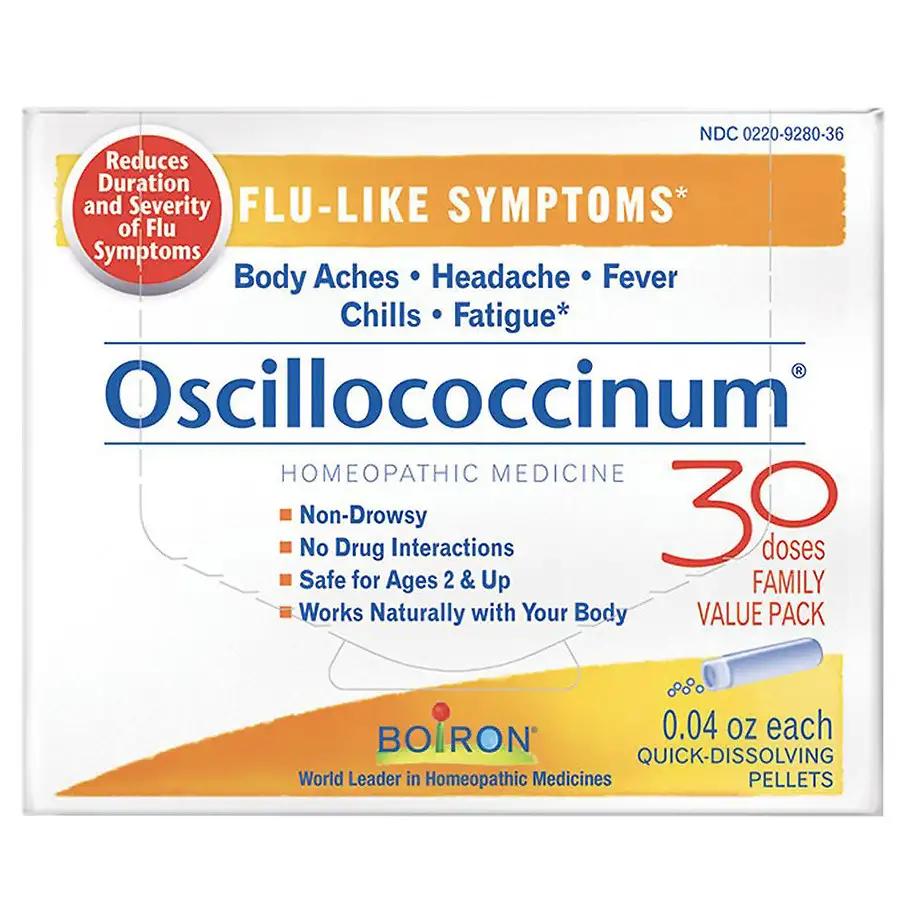 Flu Prevention + Treatment
Flu Prevention + Treatment
As I mentioned before, my entire family got the flu, or more accurately “FLI”- or “flu-like-illness” as it is officially referred to. We did not go into a doctor’s office to get an official flu test, but I can’t imagine any other virus in “flu season” being much worse than this!
I explain in this post how it started and spread through our family and a great more in detail of how we recovered, but here is a quick summary:
#1: REST and Embrace Your Fever
I go into much more detail in my post on flu care, but with influenza infection- fever is your friend. Let it work. There are ways to manage fever without breaking it. I discuss all of this in my post on caring for a family (and yourself) with the flu. Also- so important to stay hydrated with the flu!
#2: Oscillococcinum
Oscillococcinum is a homeopathic remedy shown to reduce the length of the flu when taken at the onset of symptoms. I learned of this after everyone had gotten the flu but me last year, and since I was the last one to get it I had it on hand to take for myself. Sure enough- my flu symptoms lasted half as long, really only about 3 days vs. the week it took everyone else to recover (or longer in the case of my husband!)
#3: Vitamin D3/K2 Combo
Virtually every person living a “modern” mostly indoor lifestyle is deficient in Vitamin D. Vitamin D is actually a hormone that, if deficient can noticeably affect the function of our immune system and ability to respond to infection. Vitamin D supplementation has been found to help reduce flu susceptibility and complications in children.
#4: Avoid Pneumonia Complications
The best way to avoid pneumonia complications with the flu is to keep our nasal passages clear. The best way I have found to do this is to use a nasal irrigation system such as the Neti Pot for adults or NoseFrida with saline drops for children. Again, I write more about this in my post on flu care.
#5: Additional Supplements and Garlic
There are a dozen other recommendations I have for supplements and natural remedies for flu such as garlic internally and topically, elderberry syrup, beta glucan, probiotics, and more. Find all of that in my post on flu care.
A warning about Tamiflu
In a nutshell, Tamiflu is a prescription antiviral and “go to” for pediatricians and doctors during flu season when you come into their office with the flu. The problem is that Tamiflu has been shown to be not only ineffective (perhaps shortening symptoms by a day or so maybe), but it can be extremely unsafe in children and adults.
I have reviewed all of the below articles and studies and think they do an excellent and thorough job explaining why you should avoid Tamiflu this and every flu season:
The Myth of Tamiflu: 5 Things You Should Know (Forbes Magazine)
Evaluation of the Safety and Efficacy of Tamiflu (concluded it was rushed to market with menial effectiveness and sometimes severe side effects.)
Dr. Tenpenny: Why You Should Avoid Tamiflu
British Medical Journal “Slams” Tamiflu (USA Today)
Easy to Read Article simplifying several studies on why Tamiflu is ineffective and unsafe
Bottom Line:
My experience with the flu vaccine in the past is typical of MANY people. In 2004 I received my first flu nasal vaccine at the school I was teaching at. TWO days later I came down with HORRIBLE flu. That was the first flu vaccine I had and the last- I haven’t had one since.
The next time I got the flu was nine years later- in 2013. I knowingly (and stupidly) went to someone’s house who said they had the flu the past two weeks but was better now (although they still coughed often while I was there.) The next night I quickly went downhill and was in bed the next four days with high fever and symptoms coming from every area of my body. My husband also got it that year but my kids never did (even though I nursed my 8-month old daughter the entire time.) It was wretchedly miserable, and I now know NOT to downplay how serious the flu can get. We used many of the natural remedies I discussed above and recovered completely at home.
During that particular flu recovery I actually remember thinking- “I TOTALLY see why people want to avoid this and ‘cover their bases’ by getting the flu shot” (even though it’s effectiveness is so-so and the ingredients are concerning.)
The next time flu hit our house was last Christmas through New Years Eve, 2017. I was the last to get it this time, but when it was over, all five of us in my family went through it.
At this point, I think I have settled on the fact that the flu is just part of life and part of being human. Three times with the flu in twenty years is a number I can work with and what I see as a part of the human experience.
I have read studies stating that the flu shot is effective (somewhat- even the CDC says the ~50% number that you saw above,) and studies showing it is extremely ineffective.
I have read stories of people dying from flu and of people dying after the flu vaccine.
The flu statistics over the past 100 years that I mentioned above really does show very little difference between modern mortality in America pre-flu vaccine vs. today.
Our Decision:
Frankly, I have a very difficult time trusting what the media and governing health departments say about vaccination and public health in general. Their statistical “successes” are unimpressive (~50% flu vaccine efficacy max), and yet they continue to promote universal flu vaccination with incredibly forceful and powerful language.
Their dogmatic, fearful tactics around influenza vaccination combined with complete ignorance of preventative care via healthy diet and lifestyle (with complete focus on vaccines and pharmaceutical drugs), makes the decision about the flu vaccine for my family an easy one.
We’ll pass indefinitely. 🙂

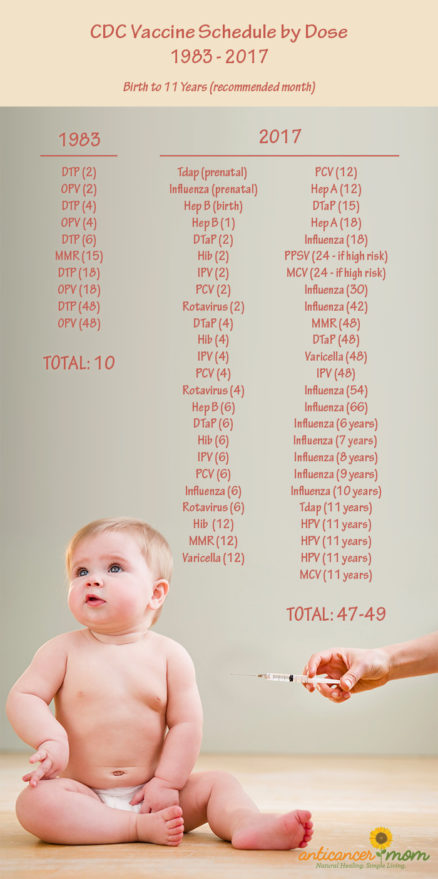
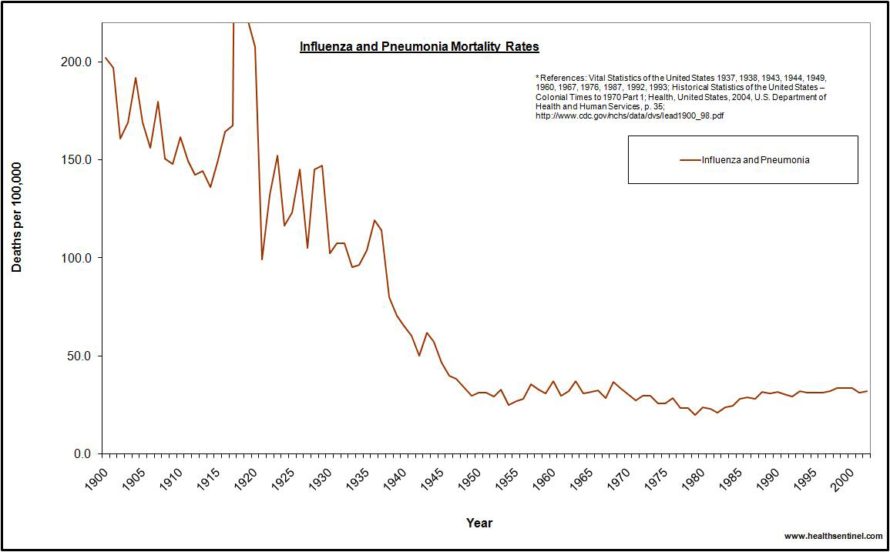

Thank you for this! Very helpful!
This is a wonderful, well-researched article that goes in depth of the flu vaccine’s history and it’s pros and cons while doing it unbiased! THANK YOU!!! I just got asked this morning at my 18 week prenatal check up if I’ve had the flu shot…after I said no I was then offered it but still declined.
Hi Cortney,
Thank you for putting so much great information (with numerous links) in this informative article! I have read and followed much of your journey, as I am about to start standard treatment (I have so many conventional medical family members!) at Emory. I plan to incorporate as much alternative treatments as I’m allowed.
I’m wondering your thoughts regarding flu vaccines for my immediate family as I will be immunocompromised for the flu season. I already have plans to utilize homemade elderberry extract.
Thank you for all you do!
Blessings,
Yogamom
Hi Yogamom,
I am not Cortney, but I would just like to let you know that the Cochrane Collaboration did a review of the research on whether getting the vaccine prevents a person from infecting other people. Their conclusion was that the evidence does NOT show that getting the vaccine keeps you from infecting others. I would plug for elderberry syrup, Sovereign Silver, lots of vitamin C, and healthy eating as being more effective. I am sorry about your health difficulties and I wish you the best of results with your treatments.
God bless,
Beth
thank you for this awesome information, Cortney! I have had the flu once…it was after getting the nasal flu vaccine which was required or else we were expelled from PA school…so against my gut and desire I got it and have never felt the same since. I got the flu and can name to the day the last time I truly felt healthy and good…it was that day before getting the flu shot. I think it tipped something inside of me to gear up some serious autoimmune issues. Anyway – thank you for all of that data which is validating after my body telling me without a doubt…no more flu shot for me! And I won’t let my kids get it either.